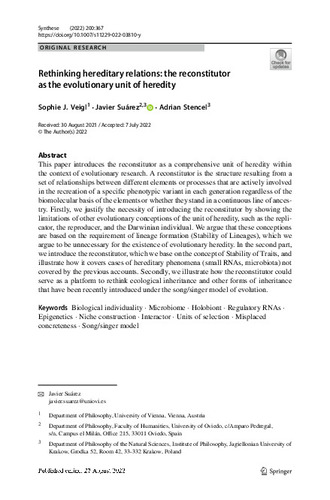Rethinking hereditary relations: the reconstitutor as the evolutionary unit of heredity
Autor(es) y otros:
Palabra(s) clave:
Biological Heredity
Inheritance
Microbiome
Small RNA
Reconstitution
Fecha de publicación:
Editorial:
Springer
Versión del editor:
Citación:
Descripción física:
Resumen:
This paper introduces the reconstitutor as a comprehensive unit of heredity within the context of evolutionary research. A reconstitutor is the structure resulting from a set of relationships between different elements or processes that are actively involved in the recreation of a specific phenotypic variant in each generation regardless of the biomolecular basis of the elements or whether they stand in a continuous line of ancestry. Firstly, we justify the necessity of introducing the reconstitutor by showing the limitations of other evolutionary conceptions of the unit of heredity, such as the replicator, the reproducer, and the Darwinian individual. We argue that these conceptions are based on the requirement of lineage formation (Stability of Lineages), which we argue to be unnecessary for the existence of evolutionary heredity. In the second part, we introduce the reconstitutor, which we base on the concept of Stability of Traits, and illustrate how it covers cases of hereditary phenomena (small RNAs, microbiota) not covered by the previous accounts. Secondly, we illustrate how the reconstitutor could serve as a platform to rethink ecological inheritance and other forms of inheritance that have been recently introduced under the song/singer model of evolution.
This paper introduces the reconstitutor as a comprehensive unit of heredity within the context of evolutionary research. A reconstitutor is the structure resulting from a set of relationships between different elements or processes that are actively involved in the recreation of a specific phenotypic variant in each generation regardless of the biomolecular basis of the elements or whether they stand in a continuous line of ancestry. Firstly, we justify the necessity of introducing the reconstitutor by showing the limitations of other evolutionary conceptions of the unit of heredity, such as the replicator, the reproducer, and the Darwinian individual. We argue that these conceptions are based on the requirement of lineage formation (Stability of Lineages), which we argue to be unnecessary for the existence of evolutionary heredity. In the second part, we introduce the reconstitutor, which we base on the concept of Stability of Traits, and illustrate how it covers cases of hereditary phenomena (small RNAs, microbiota) not covered by the previous accounts. Secondly, we illustrate how the reconstitutor could serve as a platform to rethink ecological inheritance and other forms of inheritance that have been recently introduced under the song/singer model of evolution.
Identificador local:
OA ATUO22
Notas Locales:
OA ATUO22
Patrocinado por:
Javier Suárez thanks the Narodowe Centrum Nauki (Grant Opus No: 2019/35/B/HS1/01998) for financial support. Adrian Stencel thanks the Narodowe Centrum Nauki (Grant Opus No: 2017/27/B/HS1/00290) for financial support
Ficheros en el ítem





